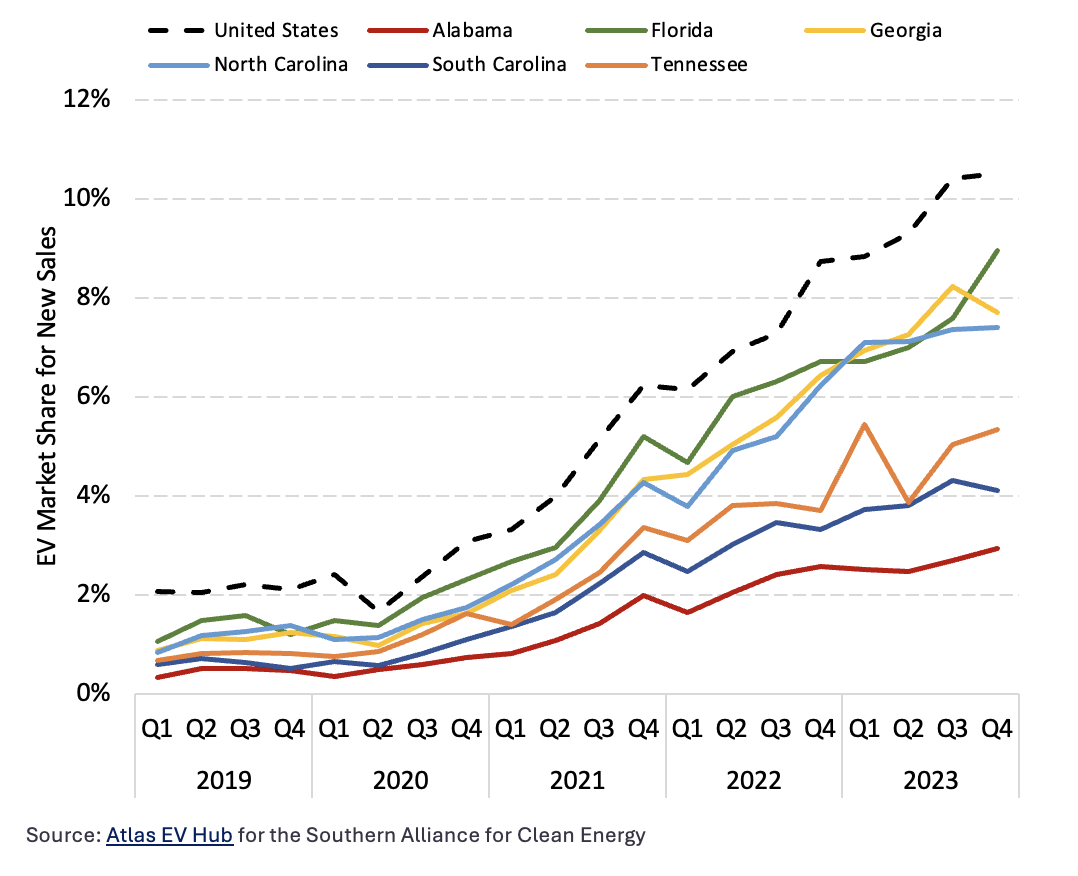Year-end market data for the Southeast shows continued growth and national leadership in EV manufacturing investments and jobs. We also see growth in sales, charging station deployment, and public funding, despite our region lagging national averages.
Stan Cross | March 7, 2024 | Clean Transportation, Electric VehiclesThe Southern Alliance for Clean Energy (SACE) and Atlas Public Policy crunched numbers for our 2023 end-of-year state and regional data update to bring more current information to layer onto our 2023 Transportation Electrification in the Southeast report. We found that the electric car, truck, and bus markets continue to grow rapidly across nearly all indicators despite recent media stories to the contrary, which we will examine in a forthcoming blog.
View the Updated State PagesRead the September 2023 Report
Southeast Electric Transportation Indicators as of December 31, 2023

A closer look at regional light-duty EV sales shows that overall growth is driven by increases across automakers as they compete with Tesla, which remains the dominant brand. EV market share as a percentage of new car sales ended the year at a regional average of 7.5%.
Southeast Light Duty EV Sales and Market Share

A closer look at market share, a good indicator of consumer sentiment, shows variation among states and continued regional lagging behind national averages. Florida, Georgia, and North Carolina lead the pack, with Tennessee, South Carolina, and Alabama trailing.
Southeast Light-Duty EV Market Share (Percentage of New Sales)

Manufacturing competition among states heats up
The biggest EV stories from our region in 2023 continue to be those around manufacturing investments and jobs. Georgia leads the region and the nation in both categories, with North Carolina moving to the #2 spot regionally ahead of #3 Tennessee and South Carolina at #4. These four Southeast states are all in the nation’s top eight EV manufacturing states, helping the Southeast secure nearly a third of the nation’s anticipated EV manufacturing jobs to date.
EV Manufacturing Facilities

The region’s manufacturing boom is part of a broader nationwide domestic manufacturing buildout driven by Made-in-America incentives in the Inflation Reduction Act (IRA), including manufacturing and consumer tax credits. These incentives are intended to shore up the domestic supply chain and increase jobs, many of which are landing in underemployed, rural communities across the Southeast.
Looking ahead to 2024
Something to watch in 2024 is the growing regional political power of EV, battery, and supply chain companies; and the important impacts it has on state-level EV policies. Thus far, the governors of Georgia, North Carolina, Tennessee, and South Carolina have been very supportive of EV manufacturing expansion, enacting executive orders, working closely with economic development agencies, and encouraging legislators to enact laws to make their states more attractive to domestic and international businesses looking to invest.
But, as shown in our 2023 Transportation Electrification in the Southeast report and our year-end updates, the region’s policymakers have largely stopped short of passing policies to encourage and support electric car, truck, and bus adoption; and in many instances, have even passed or are trying to pass unsupportive measures such as excessive EV taxes, preemption of state and local EV-ready building codes, and restrictions on regulatory authorities. Unfortunately, 2024 is unlikely to result in supportive EV policies in the region’s hyperpolarized election-year state houses.
The coming year will also see the accelerated deployment of the National EV Infrastructure (NEVI) program, funded through the Bipartisan Infrastructure Law (BIL). This program will add $5 billion of fast chargers every 50 miles along America’s highways. This buildout will help remove one of the most significant barriers to mass market adoption: the lack of accessible and reliable public charging.
Lastly, sales are likely to continue expanding throughout 2024, as showcased in J.D. Powers’s 2023 study, which revealed that 26% of new car shoppers say they are “very likely” to consider purchasing an EV and 61% are “overall likely.” Questions remain around whether legacy automakers can successfully pivot and get promised 2024 electric makes and models to showrooms, as well as how successful consumer marketing and awareness campaigns will be at engaging and inspiring consumers. Consumer Reports Electric Vehicle Survey found that only 5% of consumers have significant direct EV experience, while 34% have none. The survey also found that consumers’ willingness to purchase an EV increases as direct EV experience increases, making getting consumer butts in EV seats a priority.
The Southern Alliance for Clean Energy’s Electrify the South program leverages research, advocacy, and outreach to accelerate the equitable transition to electric transportation across the Southeast. Visit ElectrifytheSouth.org to learn more and connect with us.